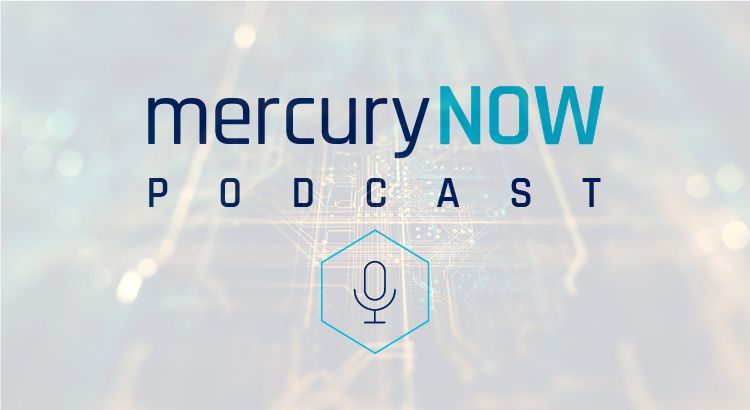
Using Data to Stop Covid-19
Mercury Systems
June 4, 2020
Data sharing across a global analytic community provides an understanding of how the Covid-19 virus spreads, a geographic understanding of the current infection densities, and its efficacy in helping end the pandemic spread of the virus. Listen in as Dr. William Conley, Chief Technology Officer for Mercury Systems, discusses how he is using this data to support the crisis response at Mercury.
Read the transcript.
Ralph Guevarez:
Hello, and welcome to Mercury Now, a podcast series brought to you by Mercury Systems. I am your host, Ralph Guevarez and today's topic. Using data to stop the virus. As Mercury builds on its position to continue to deliver quality solutions to their customers while still maintaining social distancing. I'm excited to introduce my next guest, Dr. William Conley, Chief Technology Officer for Mercury Systems. Dr. Conley, good day and welcome.
Dr. William Conley:
Hello Ralph. First off, I want to thank you for having me on the podcast today. And please go ahead and call me Bill.
Ralph Guevarez:
I appreciate that Bill. Thank you. So you've been here at Mercury for under a year. Tell us about your role and how it's changed. And if my calculations are correct, you've spent a quarter of your Mercury career with the company during our response to Coronavirus. What's different about your role now versus before?
Dr. William Conley:
Yeah, Ralph that's a great question. As you mentioned, I joined Mercury last fall. The plan at that point was the majority of my time would be spent outward focused, talking with our customers, talking with those that use the capabilities we build, identifying those longer term trends in the available technologies, as well as the changes in demand and requirements for those capabilities that we build.
Interestingly, I actually started watching the spread of the virus across Asia, back in January. As all of us stopped traveling and those external meetings grinded to a halt, I pivoted really to a critical role on the executive COVID response team, namely looking at all of the different diverse sets of data that showed the spread of the virus and now heavily focused on the predictions that show how the virus is going to keep spreading. Over the past couple of months, a lot of my time has really been focused inside of Mercury to support this crisis response. I'm excited though as we look farther into the future. I'm starting to transition more of my time back into that outward facing role. Maybe that's something we could talk about in a future podcast.
Ralph Guevarez:
I would welcome that discussion. Thank you. Now that is a major change in how you're spending your time and your ability to respond. It's obvious that you're really focused on the data. Can you tell our listeners about the data sources you're using to support the executive team?
Dr. William Conley:
Absolutely. So one of the really impressive aspects of the global response to the virus is all of the different communities that are openly sharing with each other. As our CEO, Mark Aslett said very early on in this journey, we're all in this together. And obviously that's true for all of us across Mercury, as well as the larger global analytic community.
The team at Johns Hopkins University put together the first really useful dashboard that I started following all the way back in January. That dashboard provided a geographic understanding of how the virus was spreading. As you'll remember at the beginning of the pandemic, it was really the geographic range that was important. Being able to understand if someone was traveling into an area that had a higher infection rate. At this point, now that the virus has spread globally, it's more important to understand the number of cases in a community, if that number is expected to increase or decrease. The University of Washington Institute for Health Metrics and Evaluation, often called the IHME, provides a really great ability to visualize this data for different countries, as well as at the state level across the United States. I've also been monitoring a variety of health departments at the state level to provide the best geographic understanding of the current infection densities. And lastly, I'm obviously reading numerous papers and articles each day about the virus, like many other people out there.
Ralph Guevarez:
That sounds like a lot of different sources and data to look at regularly. What are some of the things that have surprised you, that you could share with our listeners?
Dr. William Conley:
The thing that I think it's arguably the most interesting is it's really interesting to see how the models have improved over time. Many of us have obviously seen the national level predictions changed dramatically. In large part, this is really due to how the modeling parameters have improved as we continue to understand more about the virus. I remember the initial release of the IHME models, and it was great to have a forecast that predicted what could happen. Previously, all of the data was historical and it really only showed what had happened. I think of that kind of as being akin to the car. Are you looking in the rear view mirror to look at what's happened behind you, or are you looking out the front to see what's upcoming? Having that forward prediction is really helpful to make the best planning decisions that you possibly can.
However, for those of us with engineering, scientific, mathematics backgrounds, we also know that fitting exponential curves is really hard to do accurately in the presence of noise. One of the key parameters in the model is the so-called R0. R0 is a measure of the number of people that each person who is infected is likely to infect going forward.
Ralph Guevarez:
So you're saying with R0, you can estimate how many people are infected due to a specific action, like the stay at home order? Am I understanding that correctly?
Dr. William Conley:
Yeah. That's exactly the case. It gives you that ability to kind of predict what's going to happen. Initially we thought the R0 value was between two and three. More recently in some of the papers, we actually think the unmitigated value may be between five and six. For reference, what we really need to do is we need to drive the R0 value below one to end the pandemic spread of the virus. What we've also seen is a lot of really interesting insights from IHME on the other metrics that are used in their estimates. Most recently, for example, they actually began publishing the change in mobility that has occurred in each state. For example, New York state, obviously one of the hardest hit regions in the United States. So a two thirds reduction in their mobility across their state when they were at their peak. Near most of our sites, across Mercury Systems, we've seen a mobility reduction, that's about 50%.
What we're now seeing though, is as states are lifting their stay at home orders, we're seeing that mobility reduction begin to tick up, and now it's only about 25% down from kind of a average day before we had the pandemic spread of a virus. And so obviously everybody remembers when we initially talked about flattening the curve, what this really means is what we're seeing is the curve flatten, but we're not seeing the curve go back down, which is really essential for ending this overall spread of the virus. And so, for example, specifically, despite having not yet had a critical outbreak in terms of the number of cases, the most recent predictions [inaudible 00:06:30] Arizona will actually see about two to three times more cases than they currently have as we move into August. And the IHME predictions actually end in early August, is expected Arizona will have more cases then than they do today. Luckily though the actions that each of us individually can take can really change how the virus spreads across our communities.
Ralph Guevarez:
Well, that's a great point. And before I ask my next question, I'd like to discuss the Mercury community by first reading a quote from CEO, Mark Aslett, from our last earnings call. And I quote, "We will continue to monitor developments, acting thoughtfully and decisively despite the disruption and uncertainty COVID-19 brings to our daily lives. Guided by our culture and values, we will also continue to communicate with transparency and act responsibly to help ensure the health, safety and livelihoods of our employees, our number one priority." In your opinion, with all the research you've done and all the data that you've collected, is there anything you'd specifically recommend we do to reduce the virus's impact?
Dr. William Conley:
Yeah. So Ralph, I really appreciate this question. So first off to give a little bit of background I'm on several of the different return to the workplace teams. Ian Dunn, one of our senior vice presidents, general managers, is leading the holistic effort, which I think he described to you the overarching strategy in an excellent earlier podcasts that you guys recorded together. And so I'm obviously excited to see what we do across Mercury to improve our offices, our technology, to continue to support and protect our employees. However, as I just described in the IHME models, we each get a big [inaudible 00:08:13] in that mobility reduction and Mercury is very well positioned in that we can continue to deliver for our customers while maintaining social distancing. And our jobs don't require us to interact with lots of people in person each day. As a company, this means we also can focus on trying to improve the health of our local communities. We can make a big difference in stopping the virus if each of us chooses to reduce our social mobility.
I'm not saying this doesn't mean, don't go outside. But what it does mean is minimize the number of people that you're within six feet of, minimize the number of people that you interact with for more than a few minutes. Interestingly, our odds are of getting sick are actually higher at a dinner party than they are at the grocery in large part due to the fact that it's the longer time period of the interaction with a neighbor, an extended family member over dinner, as opposed to the relatively short period of time that you interact with somebody when you pass them in the grocery store. If each of us does our part and continues to minimize our social mobility, I think we can substantially reduce the spread of the virus and avoid the need for another major economic shutdown like the one we've all just experienced.
Ralph Guevarez:
Where can our listeners gather more information on the IHME model and other data sources you mentioned pertaining to COVID-19?
Dr. William Conley:
Yeah, so appreciate that Ralph. I should have mentioned those earlier. The IHME data, you can access for yourself at healthdata.org. It's a really useful site to get that feedback on a week by week basis of how things are evolving in each state. And obviously the different state department of healths are publishing their data as well. And so really appreciate that question.
Ralph Guevarez:
Bill, I'd like to take this opportunity to thank you for joining me today. I am certain the information you provided to our listeners is helpful in easing the transition back to what we are calling the next normal. I wish you safety and good health, and again, thank you for your time.
Dr. William Conley:
Yep. Thanks a lot, Ralph. I appreciate the chance to join you today.
Ralph Guevarez:
This has been another edition of Mercury Now, a podcast series brought to you by Mercury Systems. I am your host, Ralph Guevarez signing off.






 Simplifying space payloads with microelectronics
Simplifying space payloads with microelectronics Creating the next generation of mission computers
Creating the next generation of mission computers